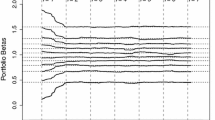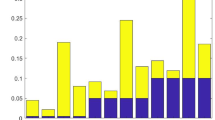Abstract
The value premium as measured by the “high minus low” returns from the Fama and French database has been negative or statistically indistinguishable from zero for the past decade. The value premium is highly variable and non-normally distributed, making traditional statistical tests like t tests or regressions difficult to implement or misleading. The authors hypothesize that the Great Moderation—a period of generally lower variability in economic growth and inflation—has not been great for the value premium. To demonstrate this, the authors use a variety of nonparametric techniques and panel analysis to show that the value premium was generally challenged by the Great Moderation. This is consistent with the idea that as a risk premium, if risk is lower, the premium should also be lower.





Source: OECD (2020), Social spending (indicator). https://doi.org/10.1787/7497563b-en (Accessed on 25 June 2020)




Similar content being viewed by others
References
Bernanke, Ben. 2004. Remarks by Governor Ben S. Bernanke, at the meetings of the Eastern Economic Association, Washington, DC, February 20, 2004. https://www.federalreserve.gov/boarddocs/speeches/2004/20040220/.
Chudik, A., M. Pesaran, and J. Yang. 2017. Half-Panel Jackknife Fixed Effects Estimation of Panels with Weakly Exogenous Regressors. Journal of Applied Econometrics 33 (6): 816–836.
Fama, Eugene, and Kenneth R. French. 1992. The Cross-section of Expected Stock Returns. Journal of Finance 47: 427–465.
Fama, Eugene F., and Kenneth R. French. 1995. Size and Book-to-Market Factors in Earnings and Returns. Journal of Finance 50: 131–156.
Fama, Eugene F., and Kenneth R. French. 2020. The value premium. January 1, 2020. Fama–Miller Working Paper No. 20-01. https://ssrn.com/abstract=3525096 or https://doi.org/10.2139/ssrn.3525096.
Gonçalves, Andrei, and Gregory, Laonard. 2020. The Fundamental-to-Market Ratio and the Value Premium Decline. April 11, 2020. Kenan Institute of Private Enterprise Research Paper. https://ssrn.com/abstract=3573444 or https://doi.org/10.2139/ssrn.3573444.
Griffin, John, and Michael Lemmon. 2002. Book-to-Market Equity, Distress Risk, and Stock Returns. The Journal of Finance 57 (5): 2317–2336.
Johnson, William, Robbie Beyl, Jeffrey Burton, Callie Johnson, Jacob Romer, and Lei Zhang. 2015. Use of Pearson’s Chi Square for Testing Equality of Percentile Profiles Across Multiple Populations. Open Journal of Statistics 5 (5): 412–420.
Lee, Wai. 2014. Constraints and Innovations for Pension Investment: The Cases of Risk Parity and Risk Premia Investing. Journal of Portfolio Management 40 (3): 12–20.
Li, Feifei. 2020. Intangibles: The Missing Ingredient in Book Value. September 4, 2020. https://ssrn.com/abstract=3686595.
Liew, Jimmy and Maria Vassalou. 2000. Can book-to-market, size, and momentum be risk factors that predict economic growth? Journal of Financial Economics 57 (2): 221–245.
McLean, David, and Jeffrey Pontiff. 2015. Does Academic Research Destroy Stock Return Predictability? The Journal of Finance 71 (1): 5–32.
Pesaran, M.H., Y. Shin, and R.J. Smith. 2001. Bounds Testing Approaches to the Analysis of Level Relationships. Journal of Applied Econometrics 16 (3): 289–326.
Peltzman, Sam. 1975. The Effects of Automobile Safety Regulation. Journal of Political Economy 83 (4): 677–726.
Piotroski, Joseph D., and Eric C. So. 2012. Identifying Expectation Errors in Value/Glamour Strategies: A Fundamental Analysis Approach. Review of Financial Studies (RFS) 25 (9): 2841–2875. https://doi.org/10.2139/ssrn.1757025.
Summer, Lawrence. 2015. Demand Side Secular Stagnation. American Economic Review 105 (5): 60–65.
Turtle, Harry J., and Kainan Wang. 2017. The Value in Fundamental Accounting Information (January 8, 2017). Journal of Financial Research (forthcoming). https://ssrn.com/abstract=2895688.
Winkelmann, Kurt, Raghu Suryanarayanan, Ludger Hentschel, and Katalin Varga. 2020. Macro-Sensitive Portfolio Strategies. Market Insight, MSCI March 2013 downloaded June 24, 2020. https://www.msci.com/documents/10199/644d6abc-24ad-4d88-bb4f-89779edba408.
Zhang, Lu. 2002. The Value Premium. November 13, 2002. Simon School of Business Working Paper No. FR 02-19. https://ssrn.com/abstract=351060 or https://doi.org/10.2139/ssrn.351060.
Zhang, Qi, Peter Hopkins, Stephen Satchell, and Robert Schwob. 2009. The link between macro-economic factors and style returns. Journal of Asset Management 10 (5): 338–355.
Author information
Authors and Affiliations
Corresponding author
Additional information
Publisher's Note
Springer Nature remains neutral with regard to jurisdictional claims in published maps and institutional affiliations.
Rights and permissions
About this article
Cite this article
Jacobsen, B., Lee, W. Macroeconomics and the value premium. J Asset Manag 22, 241–252 (2021). https://doi.org/10.1057/s41260-020-00200-2
Revised:
Accepted:
Published:
Issue Date:
DOI: https://doi.org/10.1057/s41260-020-00200-2




